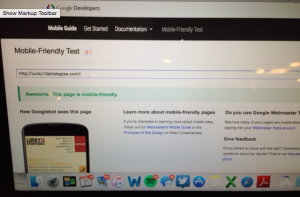We’re continuing on with Part 2 of our informational series with Search Engine Marketing (SEM) specialist Brent Curry from Lodestone Generation. In this post we’ll cover the must-know search engine lingo you keep hearing and what Google’s latest rules about mobile websites may mean for your business.
In order to do your best Search Engine Marketing, you don’t have to be a specialist – you just need to know one. However, it does help to be familiar with the buzzwords of this type of marketing, so you understand what you are paying for and why your expert is making their recommendations:
–Cost per click is the actual amount you pay per click, which is set by a formula or bidding process. This is part of Paid Search, when you bid on key phrases.
–Negative key phrases can be selected to avoid having your site show up for specific searched phrases. These are useful to avoid bringing unwanted traffic and clicks to your site. For example, if you sell (physical) desks, “help desk” could be a negative key phrase. (For more on why, see “Quality Score”, below!)
–Exact match, phrase match, broad match, and modified broad match are all options for Paid Search plans. You can customize your Paid Search plan to include a mixture of these types, individualized for your industry.
–Quality score is what Google uses to measure how relevant you’re being to the audience and your “click through rate” of how your advertisements have performed in the past. When someone googles a phrase and lands on your website, is it actually a match for their needs? This reality goes into your quality score.
–Google AdWords is a way of doing Paid Search, where you can pay to advertise your website or make it appear for specific search phrases as user inputs. As you probably notice, when you search a phrase on Google the first pages that come up are ads.
Why Having a Mobile-Friendly Website Matters to the Search Engines
In April of this year, Google changed their requirements (again). The new rules make it extremely important for a website to be mobile-friendly, or search rankings will be penalized. Now, there is a scramble to be sure websites are prepared. Is your website mobile-friendly? Google developers have provided a tool to test whether your site is mobile-friendly! Click here to see if your site complies: (https://www.google.com/webmasters/tools/mobile-friendly/)
What do Google’s new rules have to do with your business and your SEM efforts? Simply put: your website needs to be mobile-friendly or your SEM will suffer. For users, the benefits of this change are that websites that come up from a mobile search will be easier to use and very mobile-friendly. You want to be able to capture mobile traffic and you want to perform well in the rankings, so get to it!
Have a question about search engine marketing? Contact us anytime, or reach out to our friends (and sources for this article), the SEM specialists at Lodestone Generation.
Christine Buckley, Lucky 13 Strategies’ summer intern, studies Economics and Scandinavian literature at UCLA. A San Diego native, she enjoys exploring funky cafes to write and satisfy her coffee addiction. She now happily blogs for Lucky 13 Strategies, combining her two loves, business and writing.

